GE Profile Washer User Manual

Washers
Profile
ge.com
. . . . . . . . .Safety Instructions |
.2, 3 |
Owner’s Manual |
Operating Instructions
Care and Cleaning
of the Washer . . . . . . . . . . . . . . . . . . . . . . 7
Control Panel . . . . . . . . . . . . . . . . . . . . . . .4
Control Settings . . . . . . . . . . . . . . . . . .4, 5
Features . . . . . . . . . . . . . . . . . . . . . . . . . .6, 7
Loading and Using
the Washer . . . . . . . . . . . . . . . . . . . . . . . . 7
Troubleshooting Tips . . . . . .8–10
Consumer Support
Consumer Support . . . . . . . . . . . . . . . .12
Warranty . . . . . . . . . . . . . . . . . . . . . . . . . .11
Write the model and serial numbers here:
Model # ______________
Serial # ______________
You can find them under the lid of the washer.
175D1807P619 49-90351 05-08 JR
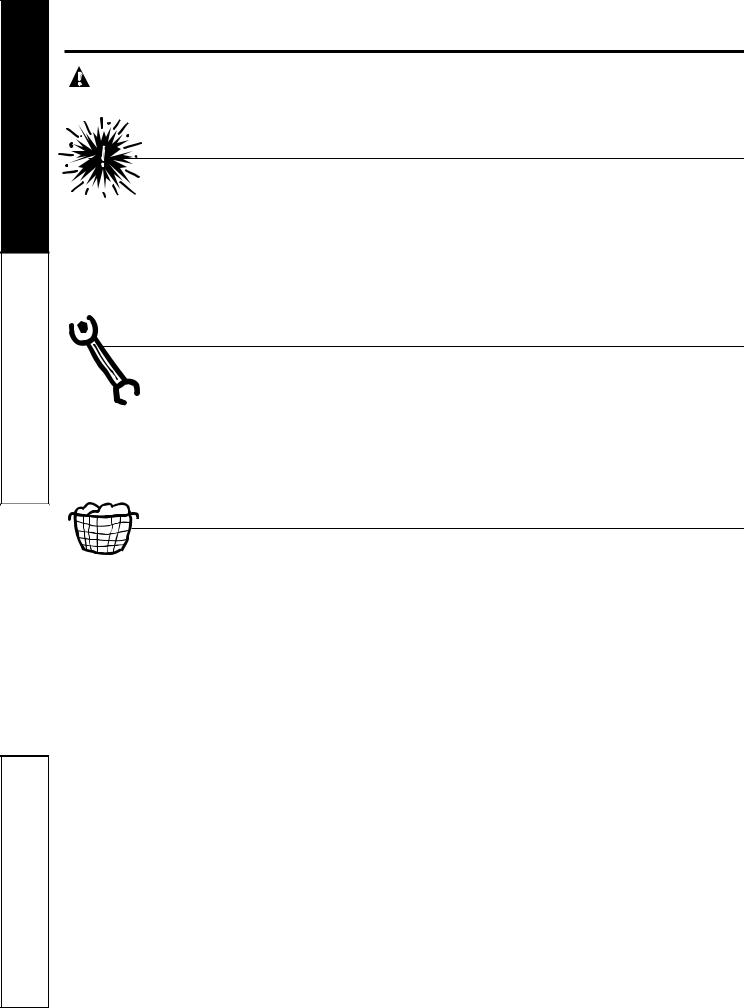
Safety Instructions
Operating Instructions
Troubleshooting Tips
Consumer Support
IMPORTANT SAFETY INFORMATION.
READ ALL INSTRUCTIONS BEFORE USING.
WARNING! For your safety, the information in this manual must be followed to minimize the risk of fire or explosion, electric shock, or to prevent property damage, personal injury,
or loss of life.
WATER HEATER SAFETY
Under certain conditions, hydrogen gas may be produced in a water heater that has not been used for two weeks or more. Hydrogen gas can be explosive under these circumstances.
If the hot water has not been used for two weeks or more, prevent the possibility of damage or injury by turning on all hot water faucets and allowing them to run for several minutes. Do this before using any electrical appliance which is connected to the hot water system. This simple procedure will allow any built-up hydrogen gas to escape. Since the gas is flammable, do not smoke or use an open flame or appliance during this process.
PROPER INSTALLATION
This washer must be properly installed and located in accordance with the Installation Instructions before it is used. If you did not receive an Installation Instructions sheet, you can receive one by visiting ge.com or by calling 800.GE.CARES (800.432.2737).
■ Install or store where it will not be exposed to |
■ Properly ground washer to conform with all |
temperatures below freezing or exposed to the |
governing codes and ordinances. Follow details |
weather, which could cause permanent damage |
in Installation Instructions. |
and invalidate the warranty. |
|
YOUR LAUNDRY AREA
■ Keep the area underneath and around your |
■ Close supervision is necessary if this appliance is |
appliances free of combustible materials such as |
used by or near children. Do not allow children to |
lint, paper, rags, chemicals, etc. |
play on, with or inside this or any other appliance. |
2
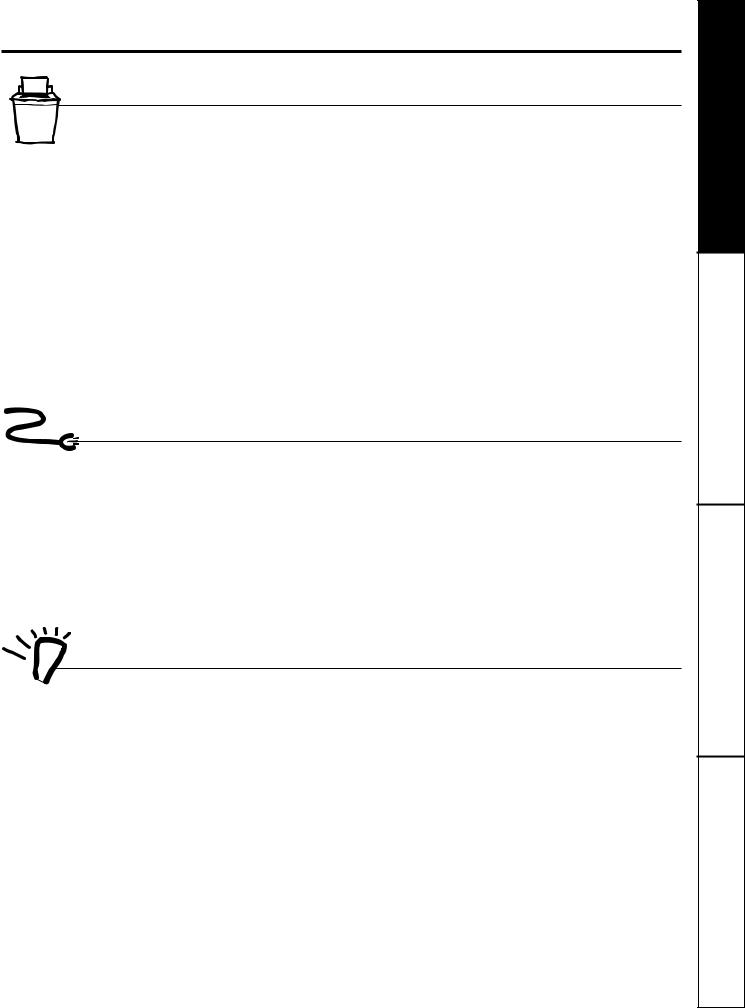
ge.com
WHEN USING THE WASHER
|
■ Never reach into washer while it is moving. |
|
|
Wait until the machine has completely stopped |
|
|
before opening the lid. |
|
Use this |
■ Do not mix chlorine bleach with ammonia or acids |
|
appliance |
such as vinegar and/or rust remover. Mixing |
|
only for its |
different chemicals can produce a |
|
intended |
toxic gas which may cause death. |
|
purpose as |
■ Do not wash or dry articles that have been |
|
described in |
||
this Owner’s |
cleaned in, washed in, soaked in or spotted with |
|
combustible or explosive substances (such as |
||
Manual. |
||
wax, oil, paint, gasoline, degreasers, dry-cleaning |
||
|
||
|
solvents, kerosene, etc.). These substances give off |
|
|
vapors that may ignite or explode. Do not add |
|
|
these substances to the wash water. Do not use or |
|
|
place these substances around your washer or |
|
|
dryer during operation. |
WHEN NOT IN USE
■The laundry process can reduce the flame retardancy of fabrics. To avoid such a result, carefully follow the garment manufacturer’s wash and care instructions.
■To minimize the possibility of electric shock, unplug this appliance from the power supply or disconnect the washer at the building’s distribution panel by removing the fuse or
switching off the circuit breaker before attempting any maintenance or cleaning.
NOTE: Turning the Cycle Selector Knob to an off position, or pressing PAUSE does NOT disconnect the appliance from the power supply.
■Never attempt to operate this appliance if it is damaged, malfunctioning, partially disassembled, or has missing or broken parts, including a damaged cord or plug.
■Turn off water faucets to relieve pressure on hoses and valves and to minimize leakage if a break or rupture should occur. Check the condition of the fill hoses; GE recommends changing the hoses every 5 years.
■Before discarding a washer, or removing it from service, remove the washer lid to prevent children from hiding inside.
■Do not attempt to repair or replace any part
of this appliance unless specifically recommended in this Owner’s Manual, or in published user-repair instructions that you understand and have
the skills to carry out.
■Do not tamper with the controls.
READ AND FOLLOW THIS SAFETY INFORMATION
 CAREFULLY.
CAREFULLY.


 SAVE THESE INSTRUCTIONS
SAVE THESE INSTRUCTIONS
3
Instructions Safety
Instructions Operating
Tips Troubleshooting
Support Consumer
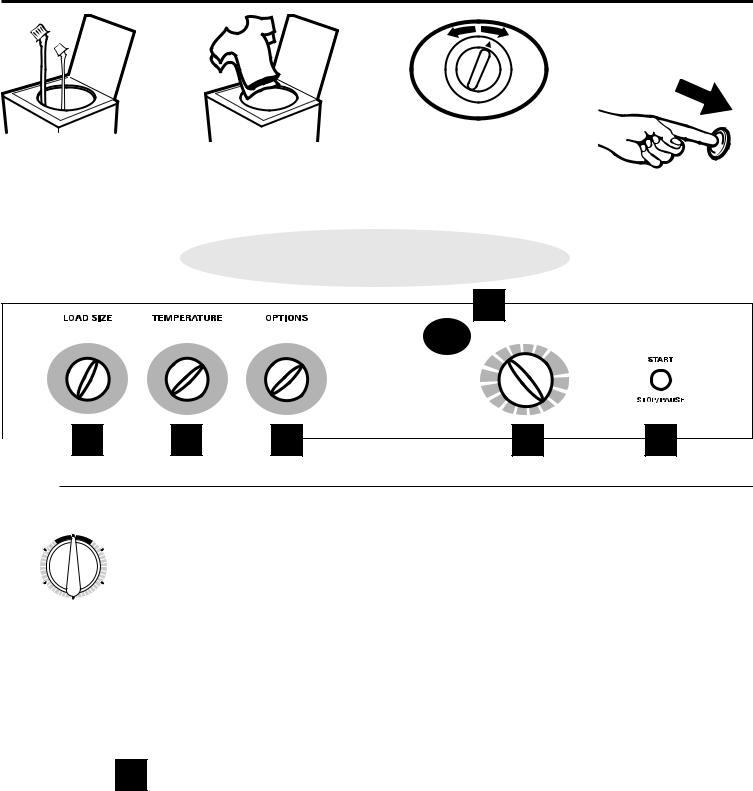
About the control panel.
Step 1 |
Step 2 |
Step 3 |
•Add detergent. GE recommends the use
of High Efficiency  detergents in all Energy Star rated washers
detergents in all Energy Star rated washers
•Add fabric softener
(on models with a fabric softener dispenser)
|
|
• Select load size and |
|
• Add clothes |
other wash options, |
||
including Fabric |
|||
• Close lid |
|||
Softener option |
|||
NOTE: Washer will not start to fill |
• Select wash cycle |
||
with lid open (on some models). |
|
||
Quick Start Guide
Step 4
• Push START
 A
A 
 B
B 
 C
C
Controls
D |
|
E |
F |
L D |
I |
|
A |
A T M T |
|
|
|
L AD SE I |
SMA L |
||
SUPE |
|
||
EX R |
|
ME I |
|
LA |
|
||
LAR
Load Size
■Add  detergent to the bottom of the basket and fabric softener to the dispenser prior to loading clothes.
detergent to the bottom of the basket and fabric softener to the dispenser prior to loading clothes.
■Loosely load clothes no higher than the top row of holes in the basket. For optimal performance, load items around the outside of the basket.
■Make the load selection from SMALL, MEDIUM, LARGE, EXTRA LARGE, SUPER and AUTOMATIC LOAD SENSING:
–For convenience, best performance and optimal efficiency, select AUTOMATIC LOAD SENSING. This selection automatically provides the correct amount of water suited to the size and type of load placed in the unit.
–If you prefer to manually select the water level, select SMALL through SUPER. While AUTOMATIC LOAD SENSING is best for most loads and general washing, you may want to manually select the load size for specialty items such as bulky, lightweight comforters or pillows, where you want to ensure a larger water level is applied. Manual load size selections should be made for wet items placed in the washer, such as soaked towels or garments.
NOTE: This is a high efficiency washing machine with pulsator wash action. This system requires less water while providing exceptional cleaning action. You may notice that the water level is lower than on your previous washer. This is normal for a pulsator-equipped washer.
Temperature
B Select the water temperature for the wash and rinse cycles. Always follow fabric manufacturer’s care label or instructions when laundering.
PerfecTemp senses the incoming water temperature and adjusts the fill water to obtain a more precise temperature range for all wash temperatures. For example, in a COLD wash selection, some warm water may be added to reach a temperature needed to better dissolve detergents. Often, detergents are not completely dissolved in very cold water, especially in cooler climates.
During winter months, when the water entering your home is colder, or for locations with very cold water year round, use the PerfecTemp plus COLD to help dissolve powdered detergents and to improve the cleaning of your clothes.
The TAP COLD feature turns the PerfecTemp feature on your washer off and uses your household tap water 4 temperature for a COLD wash. This can provide energy savings by reducing the amount of hot water used in
your wash.

ge.com
C |
AutosoakOptions Option (on some models) |
|||
|
This option begins with a brief agitation, soaks for a specified period of time, then moves through the rest of the cycle |
|||
|
automatically. On some models, this option is located on the Cycle Selector knob. |
|||
|
2nd Rinse Option (on some models) |
|||
|
When you use extra detergent or bleach to clean heavily soiled clothes, you may want to use the 2nd Rinse option. |
|||
|
It provides a second deep cold rinse. |
|||
|
Extended Spin Option (on some models) |
|||
|
Use this option to extract more water from your clothes. Clothes will be drier when this option is selected and will dry |
|||
|
more quickly in your dryer. |
|||
|
Fabric Softener |
|||
|
Set this option when adding fabric softener to the washer. |
|||
|
NOTE: Do not use fabric softener dispensing balls with this washer. They do not work correctly in high efficiency |
|||
|
washers. |
|||
|
Fabric Softener plus 2nd Rinse |
|||
|
Set this option when adding fabric softener to the washer. The 2nd Rinse option provides a second deep cold rinse. |
|||
|
Fabric Softener plus 2nd Rinse and Extended Spin |
|||
|
Set this option when adding fabric softener to the washer. The 2nd Rinse option provides a second deep cold rinse |
|||
|
and Extended Spin option will extract more water from your clothes. Clothes will contain less moisture when this option |
|||
|
is selected and the clothes will dry more quickly in the dryer. |
|||
|
Autosoak plus Extended Spin |
|||
|
This option begins with a brief agitation, soaks for a specified period of time, then moves through the rest of the cycles |
|||
|
automatically. The Extended Spin option extracts more water from your clothes. Clothes will contain less moisture when |
|||
|
this option is selected and the clothes will dry more quickly in the dryer. |
|||
|
Estimated Time Remaining Display |
|||
D |
||||
■ Displays the approximate time remaining until the end of the cycle. |
||||
|
■ If the estimated time remaining is more than 60 minutes, “1H” will flash in the display followed by the additional |
|||
|
remaining minutes. When the time remaining is less than 60 minutes, the timer will count down. |
|||
|
■ Cycle time is affected by how long it takes the washer to fill. This depends on the water pressure in your home. |
|||
|
The “smart” timer “learns” the amount of time it takes to fill your washer and adjusts the total time accordingly. |
|||
|
Wash Cycle—Cycle Selector Knob |
|||
E |
||||
The wash cycle controls the length of the washing process. The knob can be turned in either direction. Turning the Cycle |
||||
|
Selector knob after starting a cycle will stop the washer and reset the cycle to the new selection. Press START |
|||
|
to begin the new cycle selection. |
|||
|
The chart below will help you match the wash cycle setting with your clothing. |
|||
|
|
PREWASH For removing surface dirt from heavily soiled clothes. Make sure to follow with |
||
|
|
a regular wash cycle. |
|
|
|
|
CASUALS For wrinkle-free and permanent press items, and knits. |
||
|
|
|
|
|
|
|
COTTONS For heavy to lightly soiled cottons, household linens, work and play clothes. |
||
|
|
|
|
|
|
|
EASY CARE For wrinkle-free and permanent press items, and knits. |
||
|
|
|
|
|
|
|
DELICATES For lingerie and special-care fabrics with light to normal soil. |
||
|
|
|
|
|
|
|
HAND WASH For items labeled handwashable with light soils. Provides periods of agitation and soak |
||
|
|
during wash and rinse. |
||
|
|
|
|
|
|
|
SPEED WASH For lightly soiled items that are needed in a hurry. |
||
|
|
|
|
|
|
|
DRAIN & SPIN For draining the tub and spinning water out of the clothes. |
||
|
|
|
|
|
|
START |
|||
F |
||||
Press START to begin the cycle. NOTE: The lid must be closed for the washer to fill and the cycle to start. Pressing START |
||||
|
again will PAUSE the cycle and the cycle indicator light will blink. |
|||
|
To continue the cycle, press START again. If machine is paused more than 24 hours, the cycle will be cancelled. To stop |
|||
|
the cycle, hold the button for 3 seconds. If water remains in the machine, select the DRAIN & SPIN cycle to drain tub |
|||
|
and spin water out of the washer tub. |
|||
|
Raising the lid will stop the filling, agitation and spin action, but does not pause the cycle. |
|||
|
5 |
|||
Instructions Safety
Instructions Operating
Tips Troubleshooting
Support Consumer
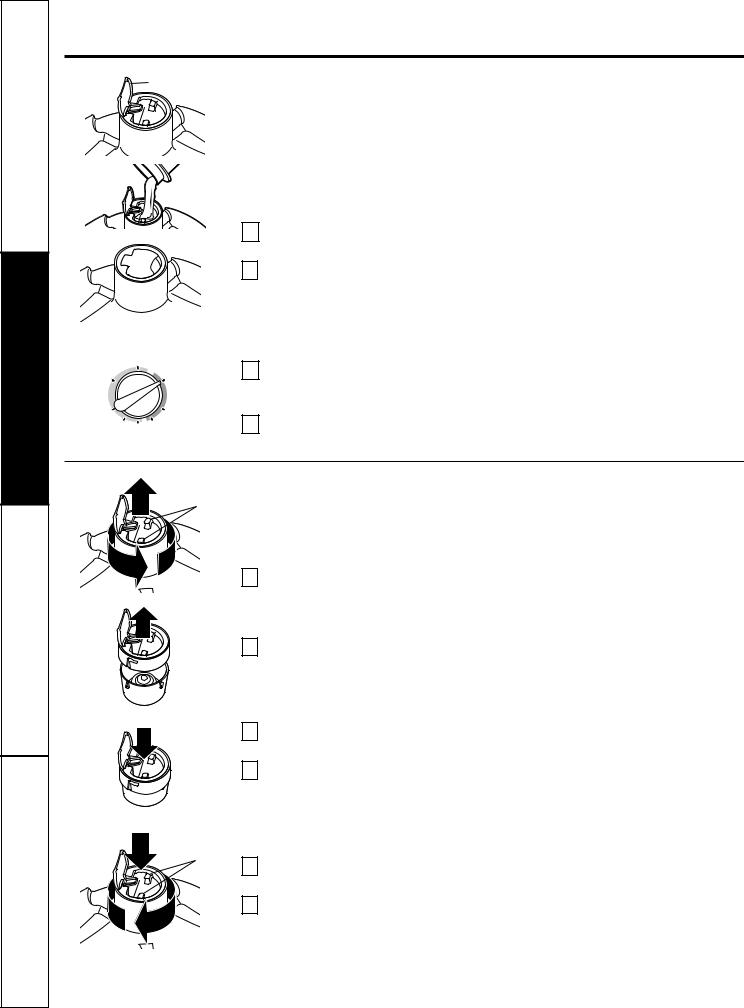
Safety Instructions
Operating Instructions
Troubleshooting Tips
Consumer Support
About washer features.
1 |
Tab |
The Fabric Softener Dispenser (on some models) |
The fabric softener dispenser automatically releases liquid fabric softener at the proper time during the cycle.
Do not stop the washer during the first spin. This will cause the dispenser to empty too soon.
2 |
Never pour fabric softener directly on clothes. It may stain them. |
To use, follow these steps:
1
3
2
4
3
|
TE ER |
S |
4 |
+ X |
E E |
|
Lift the tab on the fabric softener dispense top.
Measure out the fabric softener into the cap and pour the softener into the dispenser top. The fabric softener will drain into the receiving cup inside the dispenser. Use only “Ultra” or concentrated fabric softeners.
Push down on the tab to close
the dispenser top. Make sure the tab is pushed down fully and snaps shut.
Select FABRIC SOFTENER from OPTIONS on the control panel.
1
Turning Tabs
3
5
6
Turning Tabs
Cleaning the Fabric Softener Dispenser (on some models)
The Fabric Softener Dispenser is self cleaning. This dispenser does not require regular cleaning like standard fabric softener dispensers. Wipe down exterior surfaces of the dispenser
as needed. If cleaning of the internal dispenser components is needed, follow these steps after the wash cycle is complete:
1Lift the dispenser top tab and turn the top counterclockwise using the 2 turning tabs shown. Lift the dispenser out of the pulsator.
2Clean out any buildup from inside the pulsator with a soft cloth or toothbrush. Ensure the three rectangular holes
in the bottom which allow the fabric softener to drain are not blocked.
3Gently pull the cap away from the dispenser cup to separate.
4Wipe surfaces with a soft cloth or soak the parts in a solution of 1 gallon warm water, 1/4 cup liquid detergent and 1 cup bleach. Ensure the small hole in the top surface of the cap and associated tube are not obstructed.
5Reassemble the dispenser cup and cap by snapping them together.
6Place the dispenser assembly into
the pulsator. Turn the top clockwise using the 2 turning tabs shown. Push down
on the tab to close the dispenser top. Make sure the tab is pushed down fully and snaps shut.
6
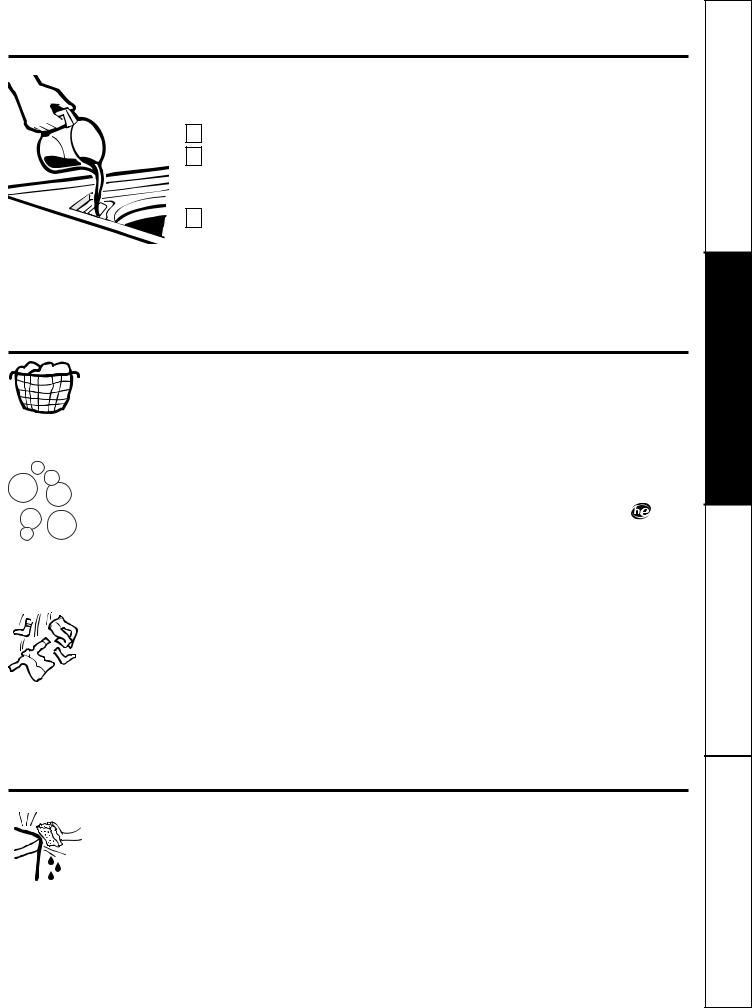
ge.com
Liquid Bleach Funnel
The water fill dilutes liquid chlorine bleach as the washer fills for the wash cycle.
1Check clothing care labels for special instructions.
2Measure liquid bleach carefully, following instructions on the bottle.
■ Never pour undiluted liquid chlorine bleach directly onto clothes or into the wash basket.
■ Do not pour powdered bleach into bleach funnel.
3 Before starting the washer, pour measured amount of bleach directly into bleach funnel. Avoid splashing or over-filling dispenser. If you prefer to use powdered bleach, add it into the wash basket with your detergent.
■Do not mix chlorine bleach with ammonia or acids such as vinegar and/or rust remover. Mixing can produce a toxic gas which may cause death.
Loading and using the washer.
Always follow fabric manufacturer’s care label when laundering.
|
|
Sorting Wash Loads |
|
|
|
Sort by color (whites, lights, colors), soil level, |
|
|
|
fabric type (sturdy cottons, easy care, delicates) |
|
|
|
and whether the fabric produces lint (terry cloth, |
|
|
|
chenille) or collects lint (velveteen, corduroy). |
|
|
|
Proper Use of Detergent |
|
|
|
Add detergent and fabric softener before adding |
GE recommends the use of High Efficiency |
|
|
clothes so that the detergent can work effectively. |
|
|
|
detergents in all Energy Star rated washers. |
|
|
|
Using too little or too much detergent is a common |
|
|
|
HE detergents are formulated to work with low water |
|
|
|
cause of laundry problems. |
|
|
|
wash and rinse systems. HE detergents reduce |
|
|
|
Use less detergent if you have soft water, a smaller |
|
|
|
the oversudsing problems commonly associated |
|
|
|
load or a lightly soiled load. |
with regular detergents. |
|
|
|
|
|
|
Loading the Washer |
|
|
|
Load dry items loosely, no higher than the top |
■ Do not place large items such as sheets, blankets |
|
|
row of holes in the washer basket. For best results, |
and towels across the pulsator. Load them around |
|
|
load items evenly and loosely around the outside |
the outside of the basket. |
|
|
of the basket. To add items after washer has started, |
■ Do not wash fabrics containing flammable |
|
|
lift the lid and submerge additional items around |
materials (waxes, cleaning fluids, etc.). |
|
|
the outside of the basket. |
■ Agitation will not start with the lid up. |
|
|
|
Care and cleaning of the washer.
Wash Basket: Leave the lid open after washing to allow moisture to evaporate. If you want to clean the basket, use a clean soft cloth dampened with liquid detergent; then rinse. (Do not use harsh or gritty cleaners.)
Fill Hoses: GE recommends changing the hoses every 5 years.
Exterior: Immediately wipe off any spills. Wipe with damp cloth. Try not to hit surface with sharp objects.
Interior: The occasional use of a cycle that contains bleach will keep the inside of the washer clean.
Moving and Storage: Ask the service technician to remove water from drain pump and hoses.
See the Installation Instructions packed with product for information on how to reinstall the shipping
rod to keep the tub stationary when moving the washer. For more information, visit ge.com
or call 800.GE.CARES (800.432.2737). Do not store the washer where it will be exposed to the weather.
Long Vacations: Be sure water supply is shut off at faucets. Drain all water from hoses if weather will be below freezing.
7
Instructions Safety
Instructions Operating
Tips Troubleshooting
Support Consumer

Safety Instructions
Operating Instructions
Troubleshooting Tips
Consumer Support
Before you call for service…
Troubleshooting Tips
Save time and money! Review the charts on the following pages,  or visit ge.com. You may not need to call for service.
or visit ge.com. You may not need to call for service.
PERFECTEMP |
Possible Causes |
What To Do |
PerfecTemp |
The washer is in a cold |
• This is normal. The PerfecTemp feature is designed not |
wash temperature |
rinse cycle |
to activate during a cold rinse cycle to improve the energy |
is incorrect |
|
efficiency of your washer. |
(Review PerfecTemp |
All the water in your |
• Wait until the water in the water heater is heated to the |
in the “About the control |
household water heater |
correct temperature. |
panel” section) |
has been used |
|
WATER |
Possible Causes |
What To Do |
|
|
|
Water fills and drains |
Drain stand pipe is too low |
• The drain stand pipe must be above 30". |
at the same time |
|
|
Too many suds |
Too much detergent |
• Measure your detergent carefully. Use less soap if you have |
|
|
soft water, a smaller load or a lightly soiled load. |
|
Type of detergent |
• Switch to HE detergent. |
|
Soft water |
• Try less detergent. |
Water leaks |
Using too much detergent |
• Use less detergent. Use less soap if you have soft water, |
|
in washer |
a smaller load or a lightly soiled load. |
|
Type of detergent |
• Switch to HE detergent. |
|
Fill hoses or drain hose is |
• Make sure hose connections are tight at faucets and |
|
improperly connected |
rubber washers are installed. Make sure end of drain hose |
|
|
is correctly inserted in and secured to drain facility. |
|
Household drain may |
• Check household plumbing. You may need to call |
|
be clogged |
a plumber. |
|
Constant water pressure |
• Tighten hoses at the faucets and turn the water off after |
|
to the fill hoses at the |
each use. |
|
water source |
• Check condition of the fill hoses; they should be replaced |
|
|
every 5 years. |
Water temperature |
Cooler water temperatures |
• New laundry detergents have been formulated to work |
seems incorrect |
provide improved energy |
with cooler water temperatures without affecting wash |
|
efficiency |
performance. |
|
Control is not set properly |
• Check water temperature control and adjust. |
|
Water supply is turned off |
• Turn both hot and cold faucets fully on and make sure |
|
or improperly connected |
hoses are connected to correct faucets. |
|
Water valve screens are |
• Turn off the water source and remove the water connection |
|
stopped up |
hoses from the upper back of the washer. Use a brush or |
|
|
toothpick to clean the screens in the machine. Reconnect |
|
|
the hoses and turn the water back on. |
|
House water heater is |
• Make sure house water heater is delivering water at |
|
not set properly |
120°F–140°F (48°C–60°C). |
Water pumped out before |
Lid lifted or cycle was put in |
• Reset cycle. |
cycle is complete |
pause for over 24 hours |
|
Water won’t drain |
Drain hose is kinked or |
• Straighten drain hose and make sure washer is not |
|
improperly connected |
sitting on it. |
|
|
• Top of drain outlet should be less than 6 ft (1.8 m) |
|
|
above floor. |
Washer pauses during |
The PREWASH Cycle or |
• This is normal. The washer alternates between agitate and |
wash cycle |
AUTO SOAK Option was |
soak during these cycles to get your clothes cleaner with |
|
chosen |
less wear. |
Washer pauses during |
This is normal |
• The washer may pause during the spin cycle to remove |
spin cycle |
|
soapy water more efficiently. |
Water level seems low |
This is normal |
• Water may not cover the top level of the clothes. |
|
|
This is normal for this high efficiency washer. |
Water does not fill when |
This is normal |
• The lid must be closed for the washer to operate. |
lid is open |
|
|
8 |
|
|
